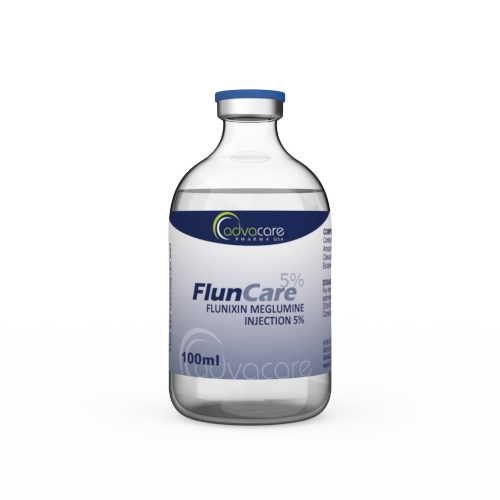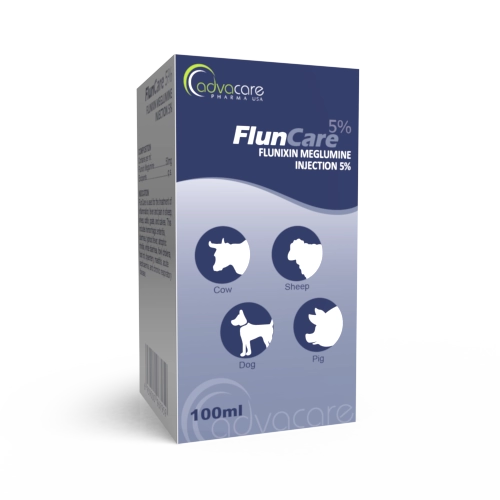What is Flunixin Meglumine?
- Anti-inflammatory
- Cat,
- Dog,
- Cow,
- Goat,
- Horse,
- Pig,
- Poultry,
- Sheep
Active Ingredients: Flunixin Meglumine
Flunixin Meglumine Injection is used to reduce pain and inflammation and control fever in many species of animals like cats, cows, dogs, goats, horses. poultry, sheep, and pigs. It relieves symptoms associated with conditions like bovine respiratory disease, endotoxemia, or acute mastitis. It is also used to treat musculoskeletal pain and visceral pain associated with colic.
Flunixin meglumine is classified as a non-steroidal, anti-inflammatory drug (NSAID). It works by inhibiting the action of cyclooxygenase. The drug operates by decreasing the synthesis of prostaglandins, which are mediators responsible for inflammation and pain. By targeting the cyclooxygenase enzyme, flunixin meglumine is able to reduce the levels of these prostaglandins, thereby mitigating the associated symptoms.
The drug’s mode of action provides both analgesic and antipyretic effects, and its efficacy is notable in alleviating visceral pain. Its rapid onset of action ensures prompt relief, making it a preferred choice for acute conditions requiring immediate attention.
Another feature of flunixin meglumine is its duration of activity. Once administered, its effects can last for an extended period. This prolonged activity not only ensures sustained relief but also reduces the potential for side effects associated with repeated dosing. Proper dosing regimens should be strictly followed to avoid any adverse effects.
Animals administered with this NSAID may experience gastrointestinal disturbances such as ulcers, erosions in the digestive tract, and potentially, perforations. Prolonged usage or overdosage might be associated with nephrotoxicity, impairing their functional ability and impacting the animal’s overall systemic health. Hemorrhaging may also happen, although rare.
Flunixin meglumine is not approved for use in humans and should not be used as an antipyretic medication in humans. It is strictly intended for veterinary use.
Basil Hygiecare is the producer and exporter of Flunixin Meglumine Injection. Our reliable and cost-effective veterinary medications are manufactured under GMP guidelines in facilities located in China, India, and the US. We routinely inspect these facilities to ensure that our products meet health, safety, and environmental standards. Our partners and distributors count on our products to be safe and effective.
Why are we a trusted Flunixin Meglumine manufacturer?
Flunixin Meglumine Injection is manufactured and globally distributed by Basil Hygiecare, a leading manufacturer of veterinary injections in the pharmaceutical industry. We have been committed to distributing high-quality, GMP-certified veterinary medications for the global market over the past 20 years. As a top Flunixin Meglumine manufacturer, we ensure that all of our 100+ veterinary injections surpass our distributors’ requirements by conducting routine internal and third-party facility audits.
Precautions
Do NOT use Flunixin Meglumine Injection for an animal that:
- has a known allergy or hypersensitivity to any of the ingredients.
- is a dairy cow in the dry period.
- is a calf intended to be slaughtered for veal.
- is a horse intended for human consumption.
- is a bull intended for breeding.
- has severe kidney dysfunction or dehydration.
- has pre-existing ulcerative gastrointestinal lesions.
Use Flunixin Meglumine Injection with caution for animals that:
- have a history of gastrointestinal ulcers or bleeding.
- are elderly or in a weakened state.
- are concurrently on other NSAIDs or corticosteroids.
- have liver or cardiovascular disorders.
- are under stress due to severe weather conditions or transport.
Consult with a veterinary specialist before combining this drug with other medications. Combining it with other NSAIDs or corticosteroids may increase the risk of gastrointestinal ulcers or bleeding or interfere with each other’s mechanism of action.
What are the most common animals Flunixin Meglumine Injection is used for?
Veterinarians usually apply Flunixin Meglumine Injection to the following animals:
- Horses: Flunixin Meglumine Injection is frequently used in horses for the management of pain and inflammation associated with musculoskeletal disorders, such as lameness or osteoarthritis. It provides analgesic and anti-inflammatory effects, helping to improve the comfort and mobility of horses.
- Cattle: In cattle, the drug is utilized for the control of pain and inflammation associated with various conditions, including bovine respiratory disease (BRD), mastitis, and endotoxemia. It helps in reducing pain, fever, and inflammation.
- Swine: Flunixin Meglumine can be used in swine for the relief of pain and inflammation caused by conditions like lameness, arthritis, and post-surgical discomfort.
- Dogs: The drug is occasionally used in dogs for the management of acute pain and inflammation resulting from conditions such as postoperative pain, soft tissue injuries, or orthopedic disorders.
Uses
What is Flunixin Meglumine used for?
It’s used to control fever (pyrexi) and relieve pain and inflammation. Its analgesic and antipyretic properties make it an effective choice for addressing post-surgical pain and other inflammatory disorders.
What animals can be treated with Flunixin Meglumine Injection?
This medicine is recommended for cats, dogs, poultry, horses and livestock animals like cows, goats, sheep, and pigs.
How is a Flunixin Meglumine Injection used?
This medication has been manufactured as a liquid, which is packaged in a vial. It is administered intravenously or intramuscularly depending on the species and specific condition being treated.
How does Flunixin Meglumine function pharmacologically?
The drug inhibits the enzyme cyclooxygenase (COX), which is essential for prostaglandin synthesis to help reduce pain, fever, and inflammation. It affects both COX-1 and COX-2 isoenzymes, which are implicated in inflammatory response and homeostasis.
Does Flunixin Meglumine have any sedative effects?
No, it does not possess sedative properties and typically does not cause sedation in animals when used within the recommended dosage range.
What is the withdrawal period for Flunixin Meglumine?
The withdrawal time is 4 days for meat and 36 hours for milk.
Is Flunixin Meglumine safe for all life stages of animals?
The safety of this medication varies across life stages and may not be suitable for very young animals or pregnant/lactating females without a veterinarian’s assessment.
Can Flunixin Meglumine be used for post-operative pain management?
Yes, depending on the veterinarian’s recommendation, it can be used to manage post-operative pain. It is known to be effective in providing analgesia and reducing inflammation following surgical procedures.
Can Flunixin Meglumine be used in conjunction with other drugs?
Certain drugs might interact adversely with NSAIDs like Flunixin Meglumine. Consult a veterinarian before initiating combination therapy.
How does Flunixin Meglumine compare to other NSAIDs in terms of potency and duration of action?
The drug is noted for its efficacy in managing visceral pain, which is not a universal trait among all NSAIDs. Its duration of action, often providing relief for 24 to 36 hours, tends to be longer-lasting than some alternative NSAIDs.
Can Flunixin Meglumine Injection be used for long-term treatment?
Flunixin Meglumine Injection is primarily intended for short-term treatment to control fever and relieve pain and inflammation in acute situations. Prolonged or continuous use may increase the risk of adverse effects and should be avoided.
What vial sizes are available?
Flunixin Meglumine Injection is available in 10ml, 30ml, 50ml, and 100ml vials per box. These options provide veterinarians and animal caregivers with the versatility to select a size that most aptly fits the dosing regimen and duration of treatment for a particular animal or group of animals.
How should Flunixin Meglumine Injection be stored?
This medication should be stored in a dark, dry location under 30°C. The vial should be sealed tightly. Once opened or punctured, the vial should be used within a specified timeframe, and the seal should remain tight to prevent contamination.
Dosage
How much Flunixin Meglumine Injection should be given to cows?
The usual dose is 1.1-2.2mg per kg of body weight, given once or divided and given twice per day. Administer by slow IV.
How much Flunixin Meglumine should be given to dogs?
The dosage for dogs typically ranges from 0.5 to 1.1mg per pound (1 to 2.2mg/kg) of body weight, given once daily or as directed by the veterinarian.
How much Flunixin Meglumine should be given to pigs?
In swine, it is often administered at a standard dosage of 2.2mg per kilogram (1mg/lb) of body weight, given once intramuscularly.
What should be done if a dose of Flunixin Meglumine Injection is missed?
Administer the missed dose as soon as possible, but if it is close to the time for the next scheduled dose, just skip the missed dose and continue with the regular schedule. Do not administer a double dose to make up for the missed one. If there are concerns or uncertainties about dosing, consult a veterinarian first.
What should be done in the event of an overdose?
Immediate veterinary attention is crucial. Overdosing can lead to gastrointestinal complications, renal dysfunction, and other systemic issues.
Refer to a veterinary doctor or pharmacist for guidelines on dosage.
Side Effects
As with all pharmaceuticals, some unwanted effects can occur from the use of Flunixin Meglumine Injection.
Some common side effects may include but are not limited to:
- pain at the site of injection
- muscle stiffness
- increased sweating
Serious side effects may include:
- allergic reactions or hypersensitivity responses
- abnormal bleeding
- swelling
- GI distress
While allergic reactions to the drug are rare, some animals might be extra sensitive. Signs of an allergy include skin rash, itching, swelling, or difficulty breathing. If any of these arise after the drug is given, seek immediate veterinary attention.
Flunixin Meglumine Injection may also have interactions with other medications, such as corticosteroids or other nonsteroidal anti-inflammatory drugs (NSAIDs).
For a comprehensive list of all possible side effects of this medication, consult a veterinarian.







